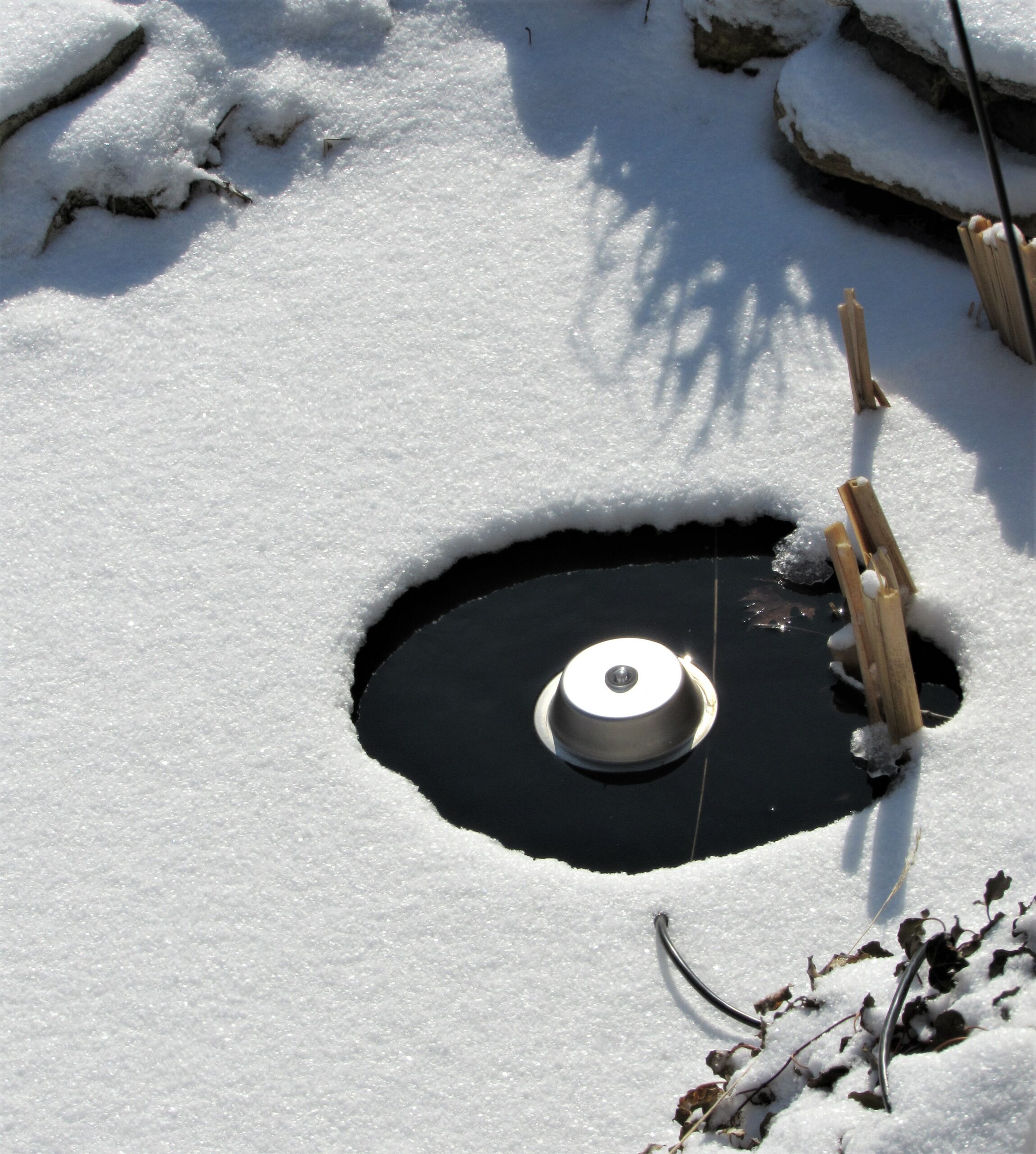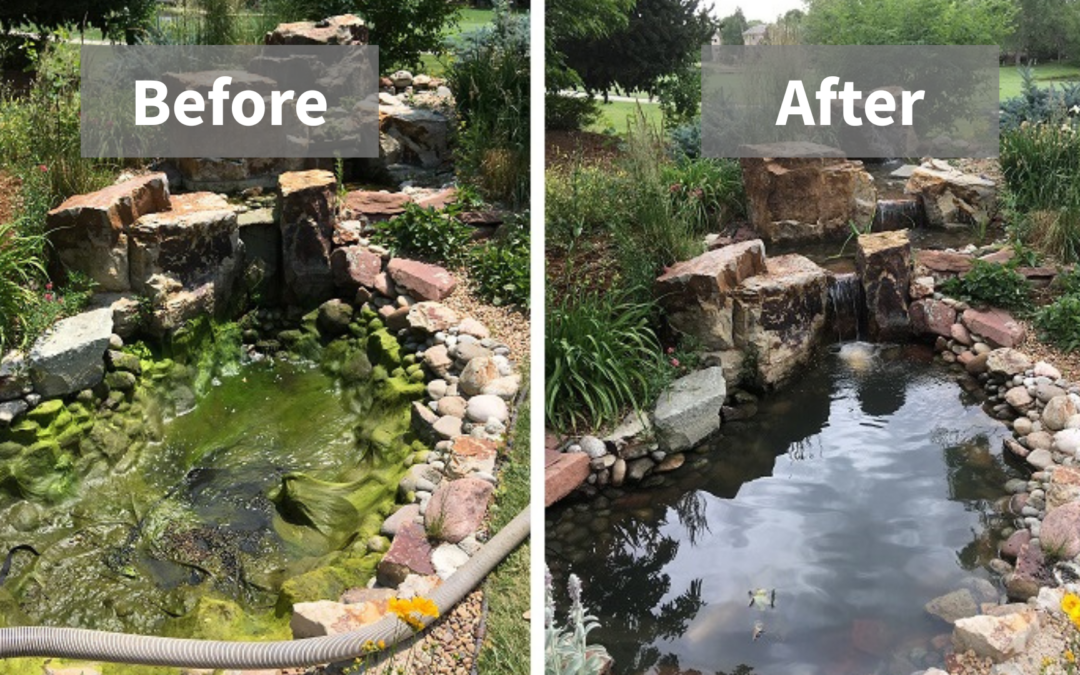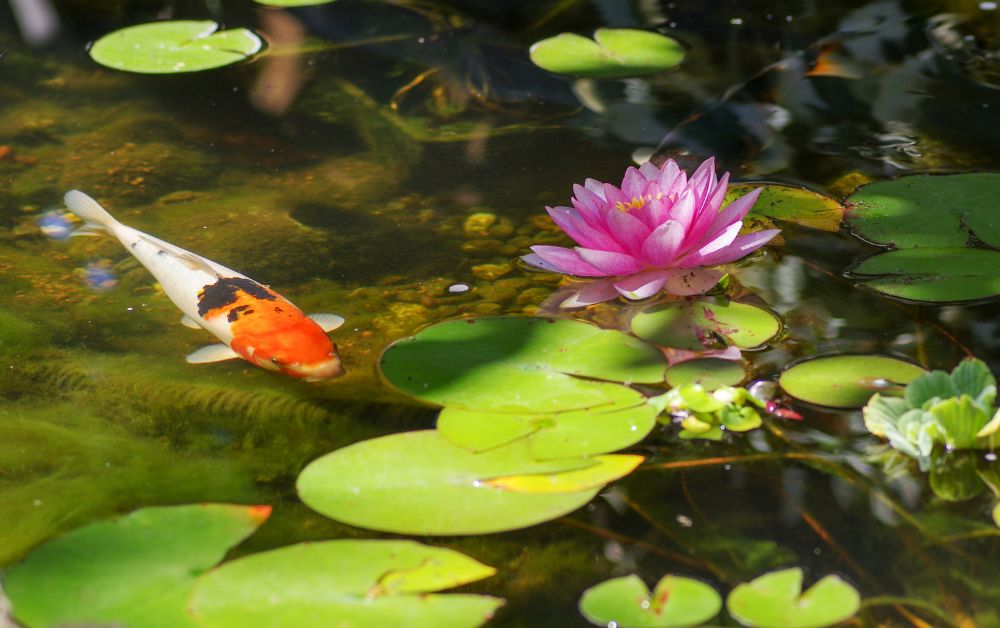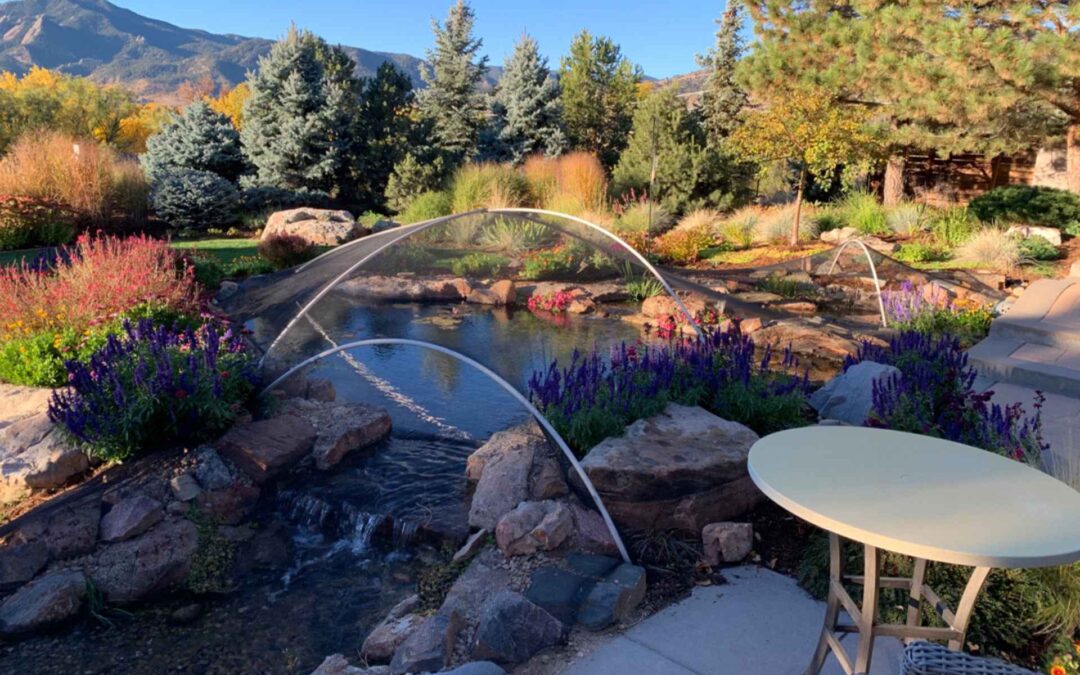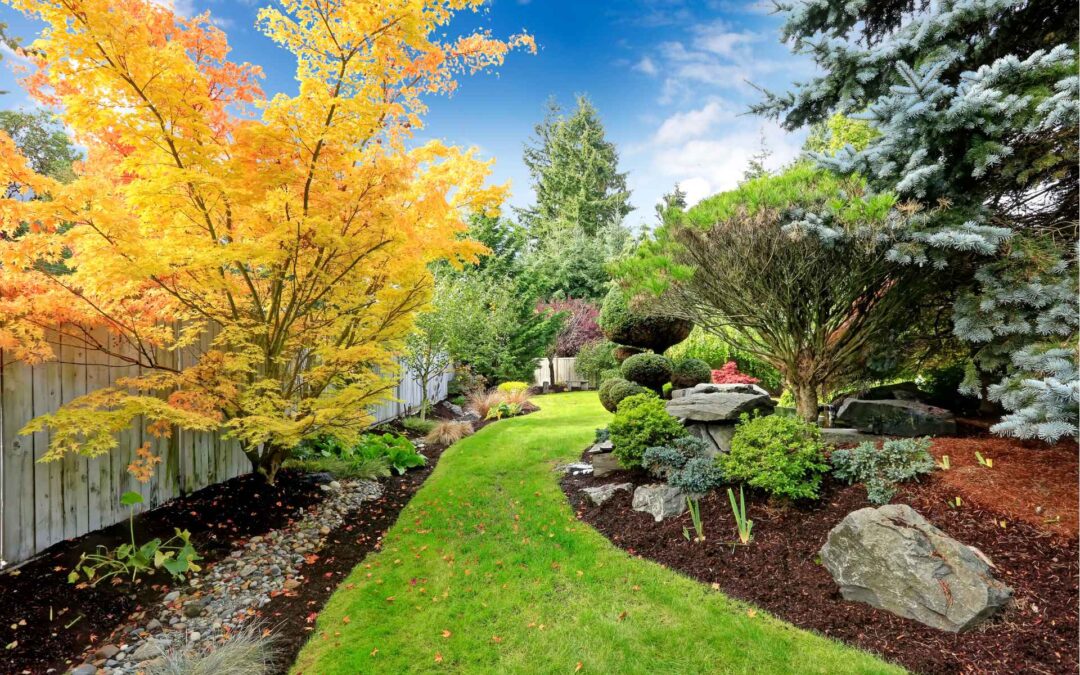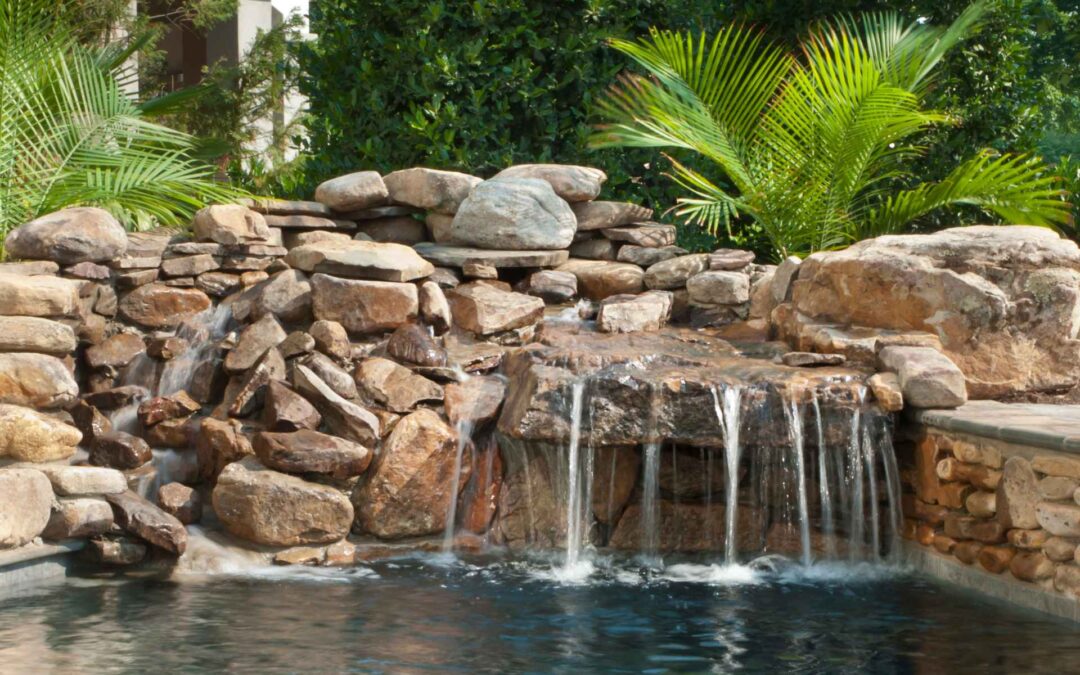What is the difference between a pond heater and a de-icer?
Great question!
The “heaters” we talk about, and that are most often referred to when talking about pond winter care, are actually de-icers. They don’t heat up a pond like a hot tub, they just keep a small space from icing over. This is necessary when there are fish present. So though we may say “heater,” we are referring to a pond de-icer.
Note: If there are no fish in your pond, this isn’t something you need to worry about!
(Shown above is the Aquascape de-icer)
It is so important to take care of your backyard ponds during the cold, Colorado winter months. If you need any help with pond repair, installation, or cleaning services, give your pond experts a call. And Colorado Pond Pros is your solution to all questions about winterizing your koi pond!
Check out our related blogs: What exactly is “Winterization” and does your system need it?
Should you run the pond over the winter? and Protecting the pond from cold weather-9 things to know.
Premier Ponds wrote a nice article on this too:
De-Icers For Ponds And How They Can Save Your Fish
It is so important to take care of your backyard ponds during the cold, Colorado winter months. If you need any help with pond repair, installation, or cleaning services, give your pond experts a call. And Colorado Pond Pros is your solution to all questions about winterizing your koi pond!
Check out our related blogs: What exactly is “Winterization” and does your system need it?
Should you run the pond over the winter? and Protecting the pond from cold weather-9 things to know.
Premier Ponds wrote a nice article on this too:
De-Icers For Ponds And How They Can Save Your Fish
It is so important to take care of your backyard ponds during the cold, Colorado winter months. If you need any help with pond repair, installation, or cleaning services, give your pond experts a call. And Colorado Pond Pros is your solution to all questions about winterizing your koi pond!
Check out our related blogs: What exactly is “Winterization” and does your system need it?
Should you run the pond over the winter? and Protecting the pond from cold weather-9 things to know.
Premier Ponds wrote a nice article on this too:
De-Icers For Ponds And How They Can Save Your Fish
The 300-watt Aquascape de-icer has an internal thermostat and only comes on when the water temperature is near freezing. This means it uses less electricity.
One of our favorite features is the light. In the picture above, the red light is on. This indicates that the heating element is on. (From your kitchen window you can tell it’s working!) The blue light indicates the deicer is not currently heating. And if there is no light, then you know the de-icer doesn’t have electricity. (We do wonder why red wouldn’t indicate being off, rather than on, but no one consulted us before the decision was made.)
The heating element stops heating if it is removed from the pond or if there is suddenly no water in the pond (hopefully that never happens). This protects the de-icer and anything near it from damage.
Pool Heaters
There are those who would put a pool heater into a pond. This can be very expensive (imagine the bill for heating a pool all winter long!). The fish will overwinter without a pool-type heater just fine, as long as there is oxygen and the water is deep enough that it doesn’t freeze the fish. (36 inches deep for koi and 24 inches deep for goldfish is plenty)
[/et_pb_text]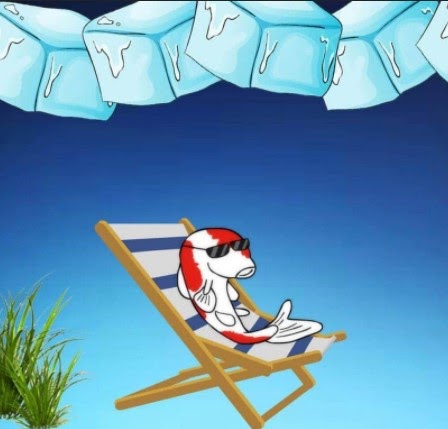
A picture of one of our koi enjoying himself under the ice last winter…okay, it’s not real…but it’s what we imagine he was doing!
Kristi’s Pond Tips
![]() Plug the de-icer into a different outlet than the pump. That way, if one goes out, the other is still working, taking care of the fish until you can remedy the issue.
Plug the de-icer into a different outlet than the pump. That way, if one goes out, the other is still working, taking care of the fish until you can remedy the issue.
![]() Don’t brush the snow off the top of the pond except to keep a hole open. The snow actually insulates the pond, keeping the temperatures warmer and more consistent.
Don’t brush the snow off the top of the pond except to keep a hole open. The snow actually insulates the pond, keeping the temperatures warmer and more consistent.
![]() Keep a hose in the house where it is warm. It will make adding water to the system easier midwinter. (Have you ever had to search under the snow for the hose, just to find it won’t work because there is ice inside blocking it? Not fun!)
Keep a hose in the house where it is warm. It will make adding water to the system easier midwinter. (Have you ever had to search under the snow for the hose, just to find it won’t work because there is ice inside blocking it? Not fun!)
It is so important to take care of your backyard ponds during the cold, Colorado winter months. If you need any help with pond repair, installation, or cleaning services, give your pond experts a call. And Colorado Pond Pros is your solution to all questions about winterizing your koi pond!
Check out our related blogs: What exactly is “Winterization” and does your system need it?
Should you run the pond over the winter? and Protecting the pond from cold weather-9 things to know.
Premier Ponds wrote a nice article on this too:
De-Icers For Ponds And How They Can Save Your Fish
The 300-watt Aquascape de-icer has an internal thermostat and only comes on when the water temperature is near freezing. This means it uses less electricity.
One of our favorite features is the light. In the picture above, the red light is on. This indicates that the heating element is on. (From your kitchen window you can tell it’s working!) The blue light indicates the deicer is not currently heating. And if there is no light, then you know the de-icer doesn’t have electricity. (We do wonder why red wouldn’t indicate being off, rather than on, but no one consulted us before the decision was made.)
The heating element stops heating if it is removed from the pond or if there is suddenly no water in the pond (hopefully that never happens). This protects the de-icer and anything near it from damage.
Pool Heaters
There are those who would put a pool heater into a pond. This can be very expensive (imagine the bill for heating a pool all winter long!). The fish will overwinter without a pool-type heater just fine, as long as there is oxygen and the water is deep enough that it doesn’t freeze the fish. (36 inches deep for koi and 24 inches deep for goldfish is plenty)
[/et_pb_text]
A picture of one of our koi enjoying himself under the ice last winter…okay, it’s not real…but it’s what we imagine he was doing!
Kristi’s Pond Tips
![]() Plug the de-icer into a different outlet than the pump. That way, if one goes out, the other is still working, taking care of the fish until you can remedy the issue.
Plug the de-icer into a different outlet than the pump. That way, if one goes out, the other is still working, taking care of the fish until you can remedy the issue.
![]() Don’t brush the snow off the top of the pond except to keep a hole open. The snow actually insulates the pond, keeping the temperatures warmer and more consistent.
Don’t brush the snow off the top of the pond except to keep a hole open. The snow actually insulates the pond, keeping the temperatures warmer and more consistent.
![]() Keep a hose in the house where it is warm. It will make adding water to the system easier midwinter. (Have you ever had to search under the snow for the hose, just to find it won’t work because there is ice inside blocking it? Not fun!)
Keep a hose in the house where it is warm. It will make adding water to the system easier midwinter. (Have you ever had to search under the snow for the hose, just to find it won’t work because there is ice inside blocking it? Not fun!)
It is so important to take care of your backyard ponds during the cold, Colorado winter months. If you need any help with pond repair, installation, or cleaning services, give your pond experts a call. And Colorado Pond Pros is your solution to all questions about winterizing your koi pond!
Check out our related blogs: What exactly is “Winterization” and does your system need it?
Should you run the pond over the winter? and Protecting the pond from cold weather-9 things to know.
Premier Ponds wrote a nice article on this too:

